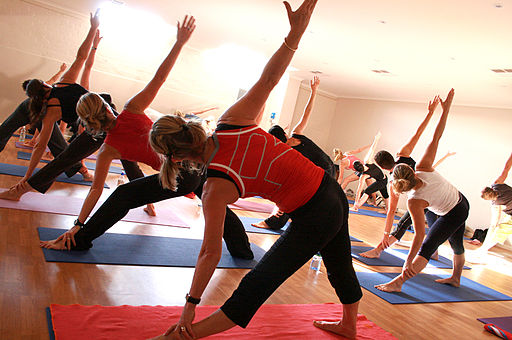A great yoga class will leave students in a state of bliss—or at least with some new level of clarity than they had when they came in.
As dedicated practitioners, we know the feeling, and as teachers we strive to create this experience.
Part of what makes a class great is the ability a person has to go deeper into their own practice. Being able to do this depends heavily on how well we understand instructions.
It takes time to hone the craft of teaching; learning to do so with grace, calm and precision requires both practice and a great deal of awareness.
I’ve had the privilege of being able to teach yoga for over a decade, and every time I step into a class I learn something new.
Instructing students with clarity, while keeping it fun and interesting is something of an art form. Here are some tips I’ve learned along the way to help the process of making class more accessible to students at every level.
7 Common Mistakes Yoga Instructors Make & How to Avoid Them
1. Making vague, esoteric references.
Let’s set the stage.
The class playlist is on point, perfectly timed to the sequences.
The vibe is relaxed, and there is a palpable energy of interconnectedness in the class.
Then it happens….we’re suddenly mid-sequence and the words “scoop up the sky and swan-dive forward,” or something equally as ambiguous comes out. Half the room elegantly folds forward, while the other half looks around puzzled, grappling for real instruction. Remember, above all else this is an opportunity to make the practice accessible to all people, so be precise about what goes into executing something.
Give clear, detailed instructions and then, take notice if students understand them, and if not try saying it another way. We impress no one but ourselves if the vast majority of people leave class confused and left out.
2. Using words like “nice” and “good” to describe the fullest expression of a posture.
For the record, there is no such thing as a “nice” backbend or a “good” stretch. Not only are these words broad, they are also subjective. As instructors when we use these words it is usually because we would like to take students deeper into a pose. For example, if students are in downward-facing dog, resist the urge to say something like “push away from the hands until you feel a ‘good’ stretch.” Rather, be more direct and take students into what they really have to do for example, “push away from your hands, as you lift your hips towards the ceiling and send your heels down closer to your mat.”
Follow this by then suggesting where they may possibly feel the stretch (i.e. the hamstrings, the backs of the shoulders etc.)
3. Using words or descriptions interchangeably.
Again, this is a nod to being clear. If in the beginning of class the verbal instruction to students is to open their arms out to the sides like “airplane wings” then 30 minutes later the verbal instruction is to put their arms alongside their bodies like “airplanes wings” the direction isn’t clear. Be consistent throughout class with explanations.
In this case, commit to sticking with one meaning of the expression “airplane wings“ (either alongside the body, or open like a capital letter T) to illustrate how ones arms should be in relation to their body, and then commit to not changing what that means later in class.
4. Saying one thing with our words, but doing something different with our own body.
This one is pretty straightforward. If we’re on the floor and asking students to get into baddha konasana (bound-angle pose) but as the instructor we are in a seated wide-legged straddle, it creates confusion. It is especially confusing to newcomers who may not know what bound-angle pose looks like and are looking to us for guidance. In classes where the practitioners are more advanced, the temptation to do what we’d like is even greater because most everyone knows what we’re asking them to do. However, keep in mind our classes are our service to the community, so let us strive to be present in both mind and body.
5. Thinking that class time is our practice time.
This tip follows the last point. It is a fact that that our personal practice time suffers once we start teaching. We must fight to keep our own practice strong. We must fight the urge to sneak in a different pose than what we’re telling the rest of the class to do. Carving out time in the week to attend classes outside our own, and committing to a strong at-home practice is essential.
It is easy to zone out, but consider why people take yoga classes—they are looking for guidance, and to practice in a safe and controlled environment. As an instructor our job is to teach and keep students safe. How easily can we make adjustments and keep a watchful eye on students if we are in a pose looking away from everyone?
That is not to say that demonstrating a pose is incorrect. Oftentimes it is advisable, especially in classes where students are newer to the practice of yoga.
Bear in mind that we are there to help, and not to turn a blind eye while we get our yoga on.
6. Saying too much.
Streamline instructions and remember less is more. Keep in mind no one learns yoga in a day, it is a life-long practice, and newcomers learn a little each time. Keep descriptions short, and when modifying it is best to limit ourselves to just one or two verbal adjustments for each pose in order to avoid confusion. Resist the desire for each pose to be done to perfection. Unless there is the potential for injury, sometimes it is just nice to see people get into the flow and ease into their bodies.
Also, no one likes an overly verbose teacher. Touch on the theme for the class, whatever it may be, but don’t feel the need to hammer it in the entire time.
The Yoga Sutras say it best:
yoga-chitta-vritti-nirodhah
Translation: Yoga is the cessation of the fluctuations of the mind.
To that end, allow students a chance to delve into the ebb and flow of yoga, without the constant chatter and direction.
7. Not allotting enough time for Savasana.
Carve out enough time for a proper period of relaxation…at least six minutes for every hour of practice. This is the portion of the class where students assimilate the benefits of the practice.
Oftentimes, students will have the desire to pack-up after the last pose and rush on out.
Jumping back into the day after a strong practice can often over-stimulate the brain, leaving it to feel scattered and nervous. Try to prevent the mad rush out by informing students of the planned time for relaxation and assure them that class will end at the time it is set to end, and encourage them to stay.
Their bodies and minds will have a chance to take in the benefits of their hard work, which will leave them feeling refreshed.
As they float out of class properly relaxed they will be grateful to both the practice and the instructor leading it.
Author: Michelle Pineiro
Editor: Renée Picard
Image: Wiki Commons







Read 0 comments and reply